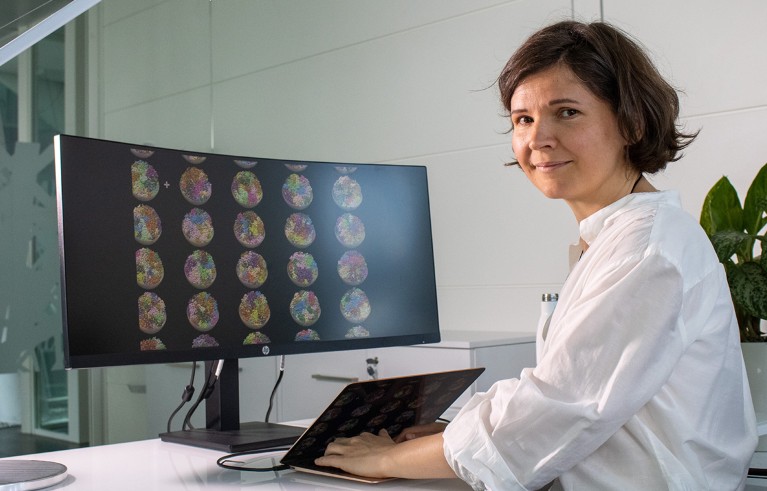In this picture I am looking at models of single-cell 3D genome structures of human cells, which we generated using software for molecular dynamics simulations, called Chromflock, developed in my lab. It uses various data as input, including those obtained by a recently developed method that makes it possible to map how DNA is spatially organised in the cell nucleus.
I joined Human Technopole last year, from the SciLife Laboratory at the Karolinska Institute in Stockholm, where I have been leading my own research group since 2015. I decided to embrace this adventure, keeping a dual appointment. A combination of private and professional life triggered this choice. The Functional Genomics Research Centre at HT seemed the right environment for both me and my Italian husband, who is also my life-long collaborator.
I fell in love with 3D genomics when I was at the Massachusetts Institute of Technology, because it’s an ideal field for interdisciplinary studies of which I am a big fan. It needs biotechnology, physics and computation. It also requires technology development in microscopy and sequencing.
Seventy years after the discovery of the structure of DNA, it is time to focus on the entire genome and to understand the function of its spatial arrangement in the entire volume of the nucleus. I want to better understand how the position of genes affects their expression. There is a general understanding that the more you go towards the centre of the nucleus, the higher the gene expression is, but it is not a black and white scenario. Indeed, there are also highly expressed genes sitting at the periphery of the nucleus.
Disruption of the 3D organization of genomes can have big effects on our health and is a factor in cancer or neurodegenerative disorders. Translocations that result in unusual rearrangement of chromosomes lead to pathologies, but to understand how that happens, we need to understand how they are linked to the structure of the surrounding genes. In the lab we make predictions starting from our sequencing data, and we test them with tools to study chromosomal organization and visualize messenger RNA transcripts. The lab has been recently awarded with an ERC Consolidator, and this will allow me to go deeper in the analysis at single cell level and trace the 3D genome structure during cell division. I would like to investigate the role of nuclear RNA in shaping genome radiality (i.e. the spatial arrangement of genome elements with respect to the cell nucleus) and how, in turns, genome radiality has an impact on nuclear processes.
I am setting up my lab trying to create an environment that is as much international as possible. Something magic happens when people find themselves far away from home and outside their comfort zone. That is also my personal story. I am from Poland, where I studied biotechnology, then I took my PhD at the Goethe University in Frankfurt and did my postdoc at MIT in Boston.
In recruiting for my lab, I abandoned the philosophy of finding the exact person with the exact specific set of skills for what I need. Instead, I usually capitalise on people with the right mindset and on their talents. Moreover, I always bet on interdisciplinarity and try to surround myself with the most diverse backgrounds, such as biology, biotechnology, medicine, physics, mathematics and engineering.
I am new to Italy, and I find the scientific environment in Milan very stimulating. My understanding is that there has been a big focus on translational research, but I think that basic research is ultimately what gives us the grounding for breakthroughs.

